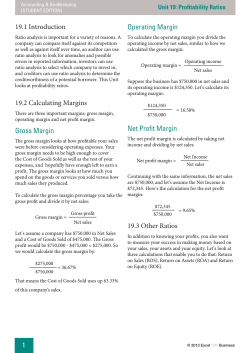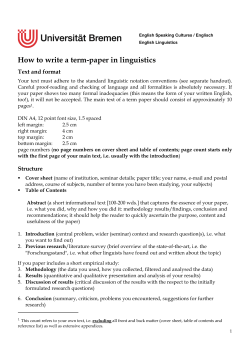
Document 254004
EECS 141: Spring 2006 Bill Hung and Dennis Wang UNIVERSITY OF CALIFORNIA AT BERKELEY COLLEGE OF ENGINEERING DEPARTMENT OF ELECTRICAL ENGINEERING AND COMPUTER SCIENCE EECS 141: Digital Integrated Circuits - Spring 2006 Report Cover Sheet TERM PROJECT: SRAM Design Cover Sheet Report 1 – Memory cell design Due Monday, March 20, 2006 by 10am in drop box. Names Bill Hung Chih-Chieh (Dennis) Wang Parameter Pre-design estimate Cell area 13.3632 (928λ2) Read noise margin 250 Voltage rise during read 393.6 Units µm2 mV mV GRADE Approach, result and correctness (60%) Report (40%) TOTAL University of California, Berkeley 1 © 2006 EECS 141: Spring 2006 Bill Hung and Dennis Wang Table of Content TERM PROJECT: SRAM Design Cover Sheet ............................................................................................. 1 Table of Figures.............................................................................................................................................. 2 PHRASE I Minimize a SRAM Cell................................................................................................................ 5 Sizing Methodology........................................................................................................................................ 5 Pull Up Transistors ..................................................................................................................................... 5 Access Transistors ...................................................................................................................................... 5 Pull Down Transistors................................................................................................................................. 6 Read Operation ............................................................................................................................................... 7 Write Operation .............................................................................................................................................. 7 HSPICE Stimulation ....................................................................................................................................... 7 Cadence Layout .............................................................................................................................................. 8 Phase I Summary ............................................................................................................................................ 8 Glossary .......................................................................................................................................................... 9 Static Noise Margin HSPICE with Pulldown Transistor Width of 1.2*0.36 .................................................. 1 Read Margin HSPICE Simulation .................................................................................................................. 3 Transient Analysis with switch ....................................................................................................................... 7 Table of Figures Figure 1 High Level SRAM array block diagram ........................................................................................... 4 Figure 2 SRAM Schematic ............................................................................................................................. 5 Figure 3 Read margin and Write margin with W1 = 0.432um. Read Margin is 450mV, which is larger than the required 400mV. ....................................................................................................................................... 7 Figure 4 Static Noise Margin VTC HSPICE Plot........................................................................................... 1 Figure 5 Read margin VTC............................................................................................................................. 3 Figure 6 Write 0 to q followed by a read ....................................................................................................... 5 University of California, Berkeley 2 © 2006 EECS 141: Spring 2006 Bill Hung and Dennis Wang SRAM Cell Design WL VDD 0.36um 0.24um M2 M5 0.36um 0.24um 0.36um 0.24um Q Q M6 0.36um 0.24um M3 M1 Cbit M4 0.48um 0.24um 0.48um 0.24um Cbit BL BL Figure 1: SRAM Cell Schematic Figure 2: Cadence SRAM Cell Layout (left) The pull-up transistors and the access transistors are minimum sized (W/L=0.36/0.24) to give a pull-up ratio of 1(<1.5). The pull-down transistors are sized W/L=0.48/0.24 to meet the 0.4V read margin. The cell ratio is 1.33(>1.2). (right) The goal of the layout is to make it work with minimum size. WL BL BL Q and Q Figure 4: HSPICE Read and Write Simulation Figure 3: HSPICE Static Noise Margin (left) Voltage Transfer Curve (VTC) of an inverter and a half cell taken from the SRAM cell. The read margin of 0.4V is met. Note that the two axises are in different scale. (right) A write simulation wrote a zero into the SRAM cell, followed by a read simulation shows the read margin is below 0.4V. Note that when the word line is low initially, Q and Q have don’t care values University of California, Berkeley 3 © 2006 EECS 141: Spring 2006 Bill Hung and Dennis Wang Figure 1 High Level SRAM array block diagram University of California, Berkeley 4 © 2006 EECS 141: Spring 2006 Bill Hung and Dennis Wang PHRASE I Minimize a SRAM Cell The phrase I involes minimizing a SRAM area, stimulating the SRAM design with HSPICE. and drawing the layout for the minimum sized SRAM using Cadence. WL VDD 0.36um 0.24um M2 0.36um 0.24um Q Q M5 M6 0.36um 0.24um 0.36um 0.24um M3 M1 0.48um 0.24um Cbit M4 0.48um 0.24um BL Cbit BL Figure 2 SRAM Schematic Sizing Methodology Pull Up Transistors The two pull up transistors (M2 and M4) in Figure 2 are minimum sized. Because the Pull Up ratio between the pull up transistors and the access transistors equals to 1 if they are all minimum sized. The pull-up ratio needs to be less than 1.8 [Rabaey, 661]. From Cadence, the minimum size is when W=0.36um, and L=0.24um. PR = W4 / L4 W6 / L6 Equation 1:Pull-up Ratio [Rabaey, 661] Access Transistors The two access transistors (M5 and M6) in Figure 2 are minimum sized. Practical designs sometimes increase the length (L) of these access transistors to improve the robustness of University of California, Berkeley 5 © 2006 EECS 141: Spring 2006 Bill Hung and Dennis Wang the SRAM design. Larger L can give less leakage because of longer channel length, but it adds more load to the bit line. In this design, the L of the access transistors are at their minimum lengths. In order to compensate for the minimum lenghts of the access transistors, the width (W) of the pull down transistors are increased. Pull Down Transistors The width of the pull down transistors (M1 and M3) is the main parameter to optimize. The goal of the minimizing is to make sure “the SRAM still works” as expected. The critical point to meet the specification to have ∆V of Q below 0.4V. That is : ∆V (Q) < 0.4V . According to the equation CR = W1 / L1 W5 / L5 Equation 2:Cell Ratio [Rabaey, 659] where CR is called t he cell ratio [Rabaey, 659] CR is about 1.2[Rabaey, 659]. So CR = W1 / L1 W1 = = 1.2 W5 / L5 W5 W1 = 1.2 ⋅ W5 If W5 is minimum sized, W1 is 1.2 times the minimum size. As HW3#3a suggested, the minimum NMOS has L=0.24um, and W=0.36um. So, W1 = 1.2 ⋅ (0.36um) = 0.432um However, with W1 = 0.432um, the read margin exceed the 0.4V specification. University of California, Berkeley 6 © 2006 EECS 141: Spring 2006 Bill Hung and Dennis Wang Read Margin 450mV > Required 400mV Figure 3 Read margin and Write margin with W1 = 0.432um. Read Margin is 450mV, which is larger than the required 400mV. Therefore, we increased the width to 0.48um, CR = 1.33, which will gives a read margin 0.3936. A read margin of 0.3936V is better than the required read margin 0.4V.Also note that the width needs to be multiple of lambda in the layout, 0.12um. At this point, both read margin and write margin are below 0.4V. Note that we could increase the width even further to lower the read margin, but since our goal is to minize the size, we used 0.48um. Read Operation The read margin has to be met. The read margin is designed so that Q does not exceed 0.4V during a read operation. Write Operation This project needs to meet the write margin. According to Professor Nikolic, the write margin is “the highest voltag on BL/ BL that writes a zero into the cell”. HSPICE Stimulation As we increase the width of the pulldown nmos transistors, the read margin decreases. University of California, Berkeley 7 © 2006 EECS 141: Spring 2006 Bill Hung and Dennis Wang Cadence Layout Phase I Summary Horizontal Length = 7.2um Vertical Height = 2.16um Area = 15.552 um2 = 1080λ2 Hours = 39 hours University of California, Berkeley 8 © 2006 EECS 141: Spring 2006 Bill Hung and Dennis Wang Glossary Area The smallest rectangle enclosing the repetitive pattern. In this case, from a contact of one side to the contact of another side. Read Margin is designed so that Q does not exceed 0.4V during a read operation. SRAM Static Random Access Memory Write Margin is “the highest voltag on BL/ BL that writes a zero into the cell University of California, Berkeley 9 © 2006 EECS 141: Spring 2006 Bill Hung and Dennis Wang 14:42:35 PST, 03/16/2006 200m 400m 600m 800m 1 1.2 1.4 1.6 1.8 2 2.2 2.4 2.6 0 500m static noise margin 1 1.5 Voltage X (lin) (VOLTS) 2 2.5 Static Noise Margin HSPICE with Pulldown Transistor Width of 1.2*0.36 Wave D0:sw0:v(qbar)) D0:sw0:v(q)) Symbol Voltages (lin) Figure 4 Static Noise Margin VTC HSPICE Plot University of California, Berkeley 1 © 2006 EECS 141: Spring 2006 Bill Hung and Dennis Wang Static Noise Margin .lib '/home/ff/ee141/MODELS/g25.mod' TT ***************************************** * Parameter ***************************************** .param vddp=2.5 .param wpulldown=0.36u*1.2 .param pmoswidth=0.36u ***************************************** * Netlist ***************************************** VDD vdd 0 'vddp' vq q 0 2.5V *M<name> <drain> <gate> <source> <bulk> <model> <geometry> M1 qbar q 0 0 M2 qbar q vdd vdd nmos l=0.24u w='wpulldown' pmos l=0.24u w='pmoswidth' ***************************************** * Analysis ***************************************** *nomod= no model info from library .options post=2 nomod *.op makes hspice determines DC operating point .op .dc vq 0 2.5 0.01 .end University of California, Berkeley 2 © 2006 EECS 141: Spring 2006 Bill Hung and Dennis Wang Read Margin HSPICE Simulation Figure 5 Read margin VTC University of California, Berkeley 3 © 2006 EECS 141: Spring 2006 Bill Hung and Dennis Wang ** inverter subcircuit .subckt my_inv vin vout vdd vss .param wpulldown='0.48u' .param pmoswidth=0.36u M1 vout vin vss vss nmos l=0.24u w='wpulldown' M2 vout vin vdd vdd pmos l=0.24u w='pmoswidth' .ends * read margin testbench .lib '/home/ff/ee141/MODELS/g25.mod' TT .inc 'circuit.sp' Vdd vdd 0 2.5 Vin VIN 0 dc 2.5 xinv Vin Vout vdd 0 my_inv M5 vblbar vdd Vout 0 nmos l=0.24u w=0.36u Vblbar vblbar 0 2.5 .dc Vin 0 2.5 0.01 .option post .END $DATA1 SOURCE='HSPICE' VERSION='V-2004.03 .TITLE 'sram project phrase' q_max_rd q_max_wr temper 1.886e-02 0.3936 25.0000 ' alter# 1.0000 * Write margin testbench (not required for the report) .lib '/home/ff/ee141/MODELS/g25.mod' TT .inc 'circuit.sp' Vdd vdd 0 2.5 Vin VIN 0 dc 2.5 xinv Vin Vout vdd 0 my_inv M6 vbl vdd Vout 0 nmos l=0.24u w=0.36u Vbl vbl 0 0 .dc Vin 0 2.5 0.01 .option post .END University of California, Berkeley 4 © 2006 EECS 141: Spring 2006 Bill Hung and Dennis Wang Figure 6 Write 0 to q followed by a read University of California, Berkeley 5 © 2006 EECS 141: Spring 2006 Bill Hung and Dennis Wang SRAM PROJECT PHRASE .lib '/home/ff/ee141/MODELS/g25.mod' TT ***************************************** * Parameter ***************************************** .param vddp=2.5 .param vwl=2.5 .param vbl=0 .param vblbar=0 * find the optimal nmos width .param w = 1.32 .param wpulldown='0.48u' .param pmoswidth=0.36u * increase the size of capacitance .param cright=.5pF .param cleft=.5pF ***************************************** * Netlist ***************************************** *M<name> <drain> <gate> <source> <bulk> <model> <geometry> M1 qbar q 0 0 nmos l=0.24u w='wpulldown' M2 qbar q vdd vdd pmos l=0.24u w='pmoswidth' M3 q qbar 0 0 nmos l=0.24u w='wpulldown' M4 q qbar vdd vdd pmos l=0.24u w='pmoswidth' M5 qbar wl blbar 0 nmos l=0.24u w=0.36u M6 q wl bl 0 nmos l=0.24u w=0.36u VDD vdd 0 'vddp' *VWL wl 0 'vwl' * generate pulses for word line and bit lines. In the first cycle, write * a zero to q; in the second cycle, read 0 from q VWL wl 0 pulse(0 2.5 .5n 0.05n 0.05n 2.5n 4n) VBLBAR blbar 0 pulse(0 2.5 .3n 0.05n 0.05n 2.7n 4n) VBL bl 0 pulse(0 2.5 4.3n 0.05n 0.05n 2.7n 8n) Cblbar blbar 0 'cleft' Cbl bl 0 'cright' ***************************************** * Analysis ***************************************** .options post=2 nomod .op .tran 0.01ns 10ns *sweep w 1.08 1.8 .06 * In both scenarios, we want to check the maximum voltage at q .meas q_max_wr max v(q) from=.6n to=3.5n .meas q_max_rd max v(q) from=4.6n to=7.5n .END University of California, Berkeley 6 © 2006 EECS 141: Spring 2006 Bill Hung and Dennis Wang Transient Analysis with switch SRAM PROJECT PHRASE .lib '/home/ff/ee141/MODELS/g25.mod' TT ***************************************** * Parameter ***************************************** .param vddp=2.5 .param vwl=2.5 .param vbl=0 .param vblbar=0 * find the optimal nmos width .param w = 1.32 .param wpulldown='0.48u' .param pmoswidth=0.36u * increase the size of capacitance .param cright=.5pF .param cleft=.5pF ***************************************** * Netlist ***************************************** *M<name> <drain> <gate> <source> <bulk> <model> <geometry> M1 qbar q 0 0 nmos l=0.24u w='wpulldown' M2 qbar q vdd vdd pmos l=0.24u w='pmoswidth' M3 q qbar 0 0 nmos l=0.24u w='wpulldown' M4 q qbar vdd vdd pmos l=0.24u w='pmoswidth' M5 qbar wl blbar 0 nmos l=0.24u w=0.36u M6 q wl vx 0 nmos l=0.24u w=0.36u * syntax for ideal switch: G1 node1 node2 VCR PWL(1) node3 V Resistance * V Resistance, where node3 is the controlling voltage. For example, the * syntax below said that the switch is controlled by phi1; if it is 0V, * the off resistance is 100Gohm; if it is 2.5V, the on resistance is 1uohm G1 vx bl VCR PWL(1) phi1 0 0,100G 2.5,1u *G2 vx 0 VCR PWL(1) phi1 0 0,100G 2.5,1u * controlling voltage source Vphi1 phi1 0 pwl(0 0 .4n 0 0.4000001n 2.5 4.4n 2.5 4.4000001n 0 ) VDD vdd 0 'vddp' *VWL wl 0 'vwl' * generate pulses for word line and bit lines. In the first cycle, write * a zero to q; in the second cycle, read 0 from q VWL wl 0 pulse(0 2.5 .5n 0.05n 0.05n 2.5n 4n) VBLBAR blbar 0 pulse(0 2.5 .3n 0.05n 0.05n 2.7n 4n) VBL bl 0 pulse(0 2.5 4.3n 0.05n 0.05n 2.7n 8n) Cblbar blbar 0 'cleft' Cbl bl 0 'cright' ***************************************** * Analysis ***************************************** .options post=2 nomod .op .tran 0.01ns 10ns *sweep w 1.08 1.8 .06 * In both scenarios, we want to check the maximum voltage at q .meas q_max_wr max v(q) from=.6n to=3.5n .meas q_max_rd max v(q) from=4.6n to=7.5n .END University of California, Berkeley 7 © 2006
© Copyright 2025









